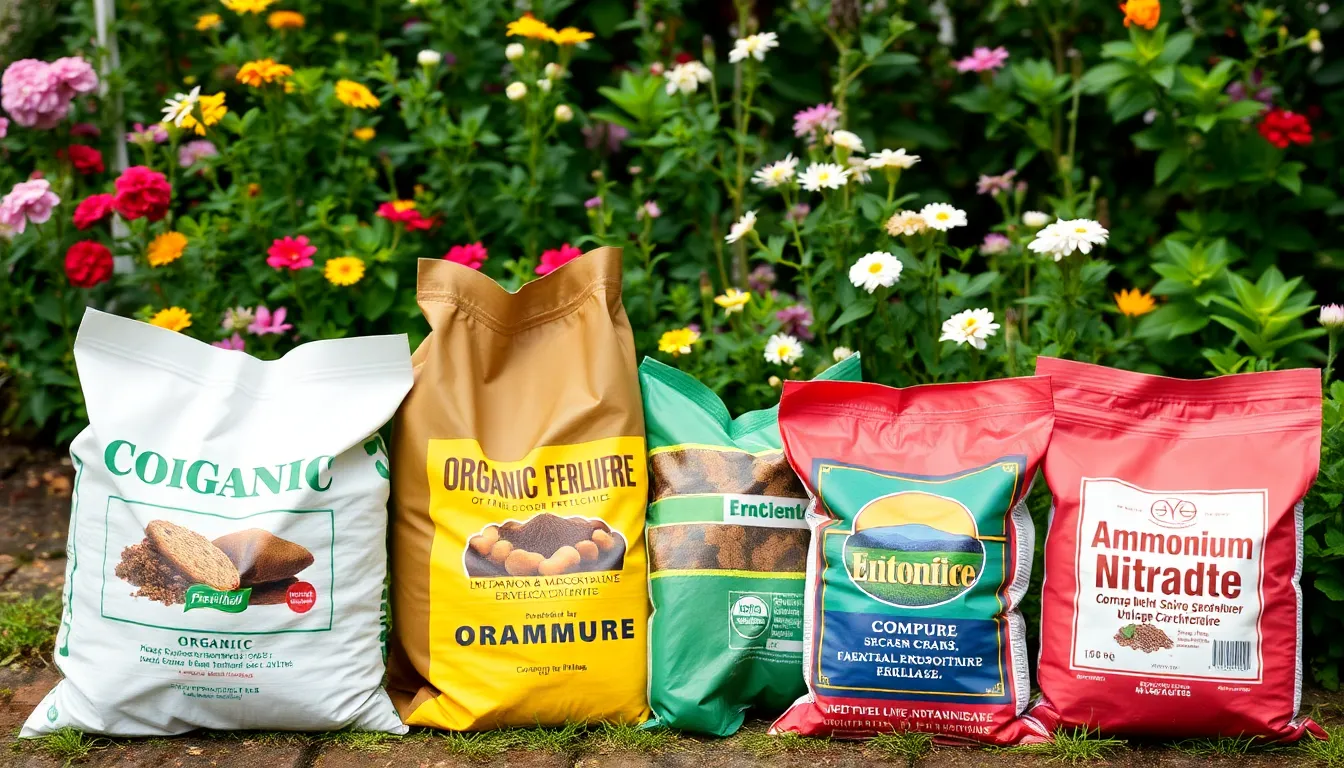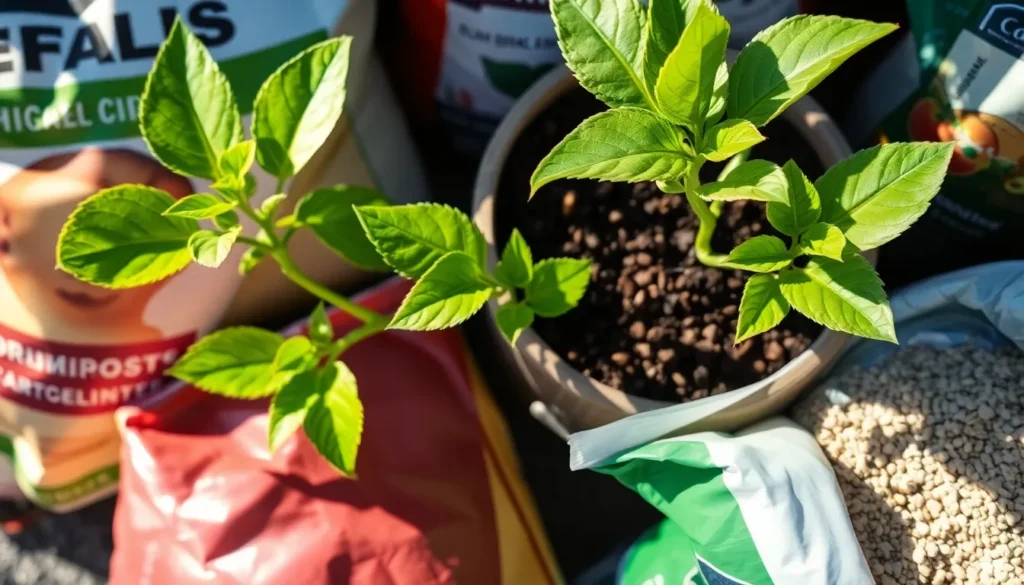Table of Contents
ToggleEvery plant parent knows the struggle: you water, you prune, and yet those poor green babies still look a bit sad. Enter plant fertilizer—the superhero your garden never knew it needed. It’s like a multivitamin for your plants, giving them the nutrients they crave to thrive and flourish.
Overview Of Plant Fertilizer
Plant fertilizer serves as a critical component for enhancing plant growth by supplying essential nutrients. Nutrients fall into two categories: macronutrients and micronutrients. Macronutrients, such as nitrogen, phosphorus, and potassium, contribute significantly to plant development. Micronutrients, including iron, manganese, and zinc, play supporting roles that are equally important for plant health.
Fertilizer types vary based on their composition. Organic fertilizers, derived from natural sources like compost and manure, enrich soil while improving its structure. Synthetic fertilizers, produced chemically, offer concentrated nutrients with immediate availability to plants. Each option presents unique benefits and fits specific gardening needs.
Proper application timing enhances fertilizer effectiveness. Applying during the growing season ensures that plants receive nutrients when they require them most. Too much fertilizer can lead to nutrient burn, harming plants instead of promoting growth. Thus, following recommended application rates avoids potential damage.
Understanding the growth stage of plants guides fertilizer use. Seedlings benefit from low-nitrogen fertilizers, fostering healthy root development. Established plants often require balanced fertilizers to support overall growth and flowering. Regular soil testing provides insights into nutrient levels, allowing for informed fertilizer decisions.
Knowledge of fertilizer labels is crucial for effective use. Labels indicate nutrient ratios, expressed as N-P-K values, showing the percentage of nitrogen, phosphorus, and potassium contained. Choosing the right fertilizer involves matching these values to plant needs. This ensures optimal growth and minimizes excess nutrient runoff, which can negatively impact the environment.
Types Of Plant Fertilizers

Understanding the types of plant fertilizers helps in selecting the right option for optimal plant health. Fertilizers generally fall into two main categories: organic and inorganic.
Organic Fertilizers
Organic fertilizers originate from natural sources. Common materials include compost, manure, and bone meal. These fertilizers contribute not only to soil health but also to sustainable gardening practices. They enhance soil structure and microbial activity while providing essential nutrients. Nutrients release slowly over time, reducing the risk of over-fertilization. Additionally, organic options support environmental safety, making them ideal for gardens focused on eco-friendliness.
Inorganic Fertilizers
Inorganic fertilizers consist of synthetic compounds. These products offer concentrated nutrients, ensuring quick absorption by plants. Common examples include ammonium nitrate and potassium sulfate. Inorganic options often provide a precise nutrient ratio tailored to specific plant needs. Rapid nutrient release promotes vigorous growth, particularly during the growing season. It’s crucial for gardeners to monitor application to prevent nutrient leaching and maintain soil health.
Benefits Of Using Plant Fertilizers
Plant fertilizers play a vital role in promoting plant health and development. By supplying essential nutrients, they ensure that plants grow strong and flourish.
Improved Plant Growth
Improved plant growth stems from the availability of crucial nutrients. Nitrogen fosters leafy growth, while phosphorus promotes robust root systems and flowering. Potassium enhances overall plant vigor and resistance to disease. When plants receive the right balance, they exhibit vibrant foliage and increased yields. Fertilizers can also accelerate growth during critical periods, such as springtime or when transitioning to larger pots. Specific formulations address the needs of various plant types, ensuring optimal results.
Enhanced Soil Health
Enhanced soil health results from the right fertilizer. Organic options enrich soil structure, promote microbial activity, and increase water retention. These improvements lead to a sustainable ecosystem beneath the surface. Fertilizers containing organic matter, like compost, bolster soil nutrition and biodiversity. Microbes thrive in nutrient-rich soils, which further aids in nutrient availability for plants. Regular use of fertilizers helps restore nutrients depleted through growth, contributing to long-term soil vitality. Healthy soil supports plants through better drought resistance and improved nutrient uptake.
How To Choose The Right Plant Fertilizer
Choosing the right plant fertilizer involves understanding specific nutrient requirements and considering the type of plants being nurtured.
Understanding Nutrient Needs
Plants require three primary macronutrients: nitrogen, phosphorus, and potassium. Nitrogen supports foliage growth, phosphorus is essential for root development, and potassium boosts overall plant vigor. Micronutrients, such as iron and manganese, also play a critical role in maintaining plant health. Soil tests help identify nutrient deficiencies accurately. Matching fertilizer formulation to these needs enhances plant growth significantly. When a plant shows yellowing leaves, it often indicates a nitrogen deficiency, while poor blooming may suggest a lack of phosphorus. Assessing these signs ensures effective fertilization.
Considering Plant Type
Different plants thrive with varying fertilizer types. For example, leafy greens benefit from fertilizers high in nitrogen, while flowering plants require a balanced mix. Houseplants often need slower-releasing organic fertilizers for steady nutrient supply. Succulents and cacti thrive on much less fertilizer, so a diluted solution can prevent over-fertilization. Understanding a specific plant’s requirements allows for customized care. Additionally, knowing whether a plant prefers acidic or alkaline soil can guide the choice of fertilizer. Such considerations maximize growth potential and overall plant vitality.
Application Methods For Plant Fertilizers
Applying plant fertilizers effectively enhances nutrient absorption and promotes healthy growth. Various methods exist to suit different fertilizers and plant types.
Granular Application
Granular fertilizers offer a simple application method. Just sprinkle the granules evenly around the plant’s base. Water the area lightly to help dissolve the particles and initiate nutrient release. Some gardeners prefer this method for slow-release fertilizers, which provide a steady supply of nutrients. Spreading granules too close to the plant stems can lead to root burn, so maintaining a few inches of distance is important. Regular application every 4 to 6 weeks supports consistent nutrient availability during the growing season.
Liquid Application
Liquid fertilizers serve as a quick response option for feeding plants. Mix the liquid with water according to package instructions, ensuring proper dilution. Apply the mixture directly to the soil or foliage, targeting the plant’s root zone. This method promotes rapid nutrient uptake, ideal for plants in active growth stages. Applying liquid fertilizer every 2 to 4 weeks can enhance nutrient delivery. However, avoid applying during periods of high heat to prevent leaf burn when using foliar sprays.
Plant fertilizer plays a crucial role in nurturing healthy plants and enhancing growth. With the right balance of nutrients tailored to specific plant needs, gardeners can ensure vibrant foliage and robust yields. Whether opting for organic or synthetic options, understanding application methods and timing can make a significant difference in results. Regular soil testing and careful observation of plant health help inform fertilization strategies. By investing in proper fertilization practices, plant parents can cultivate thriving gardens and contribute to a sustainable ecosystem. Embracing these principles will lead to flourishing plants and a rewarding gardening experience.







